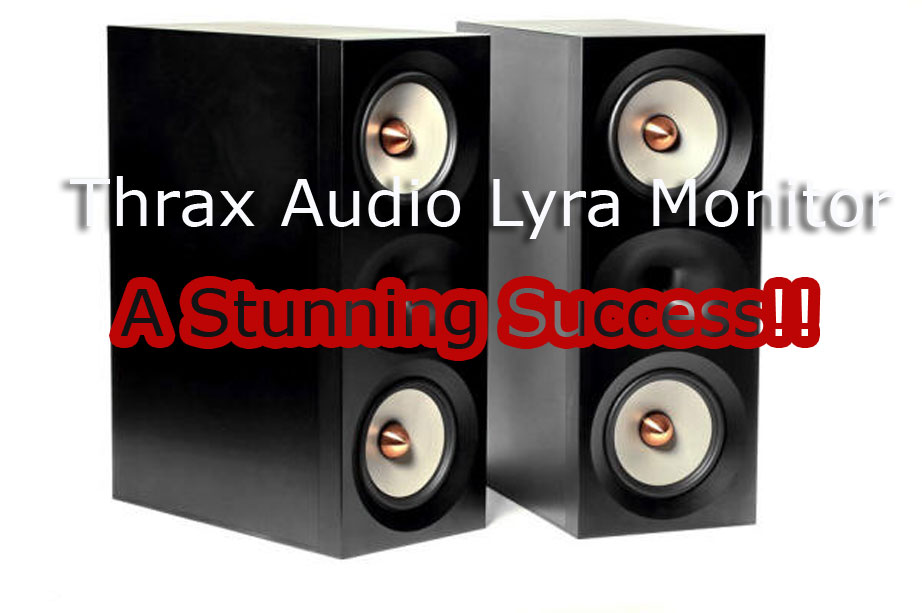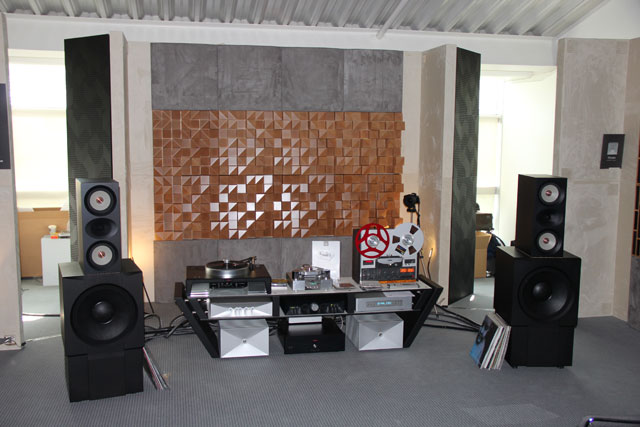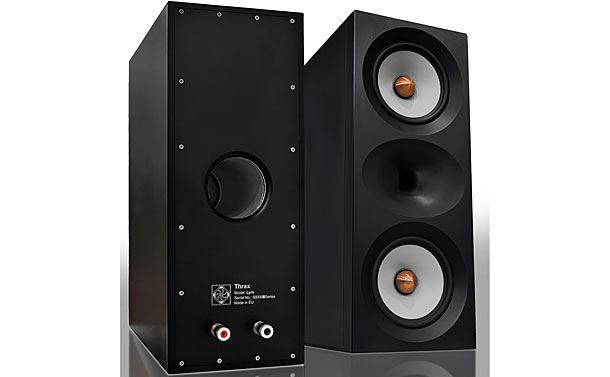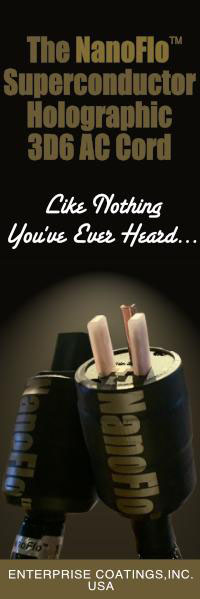Thrax Audio Lyra Monitor loudspeakers


 When I first reviewed the Thrax Dionysos preamplifier back in early 2014 (here), Rumen Artaski chief designer of Thrax Audio told me that he had been working on a new loudspeaker. Not surprisingly, at High End 2015 in Munich, Germany, Artaski dropped a bomb in everyone’s lap as officially he debuted his first loudspeaker, the Lyra two-way stand mounted monitor (photo right). This first time listen had me marveling over the Lyra’s quickness, inner detail, transparency and full-bodied-ness. This, of course, says a lot considering this is a small stand-mounted monitor. The Lyra was so impressive in fact, that I asked Artaski for a review sample. He agreed to send them to me but he warned me not to like them too much. I’ve been afflicted with the Thrax Virus over the past few years and as a result my reference system is now composed of Thrax audio components through and through.
When I first reviewed the Thrax Dionysos preamplifier back in early 2014 (here), Rumen Artaski chief designer of Thrax Audio told me that he had been working on a new loudspeaker. Not surprisingly, at High End 2015 in Munich, Germany, Artaski dropped a bomb in everyone’s lap as officially he debuted his first loudspeaker, the Lyra two-way stand mounted monitor (photo right). This first time listen had me marveling over the Lyra’s quickness, inner detail, transparency and full-bodied-ness. This, of course, says a lot considering this is a small stand-mounted monitor. The Lyra was so impressive in fact, that I asked Artaski for a review sample. He agreed to send them to me but he warned me not to like them too much. I’ve been afflicted with the Thrax Virus over the past few years and as a result my reference system is now composed of Thrax audio components through and through.
 The Lyra loudspeakers arrived in sturdy wooden boxes with thoughtful carrying handles as other Thrax equipment has and the stands arrived in a big wooden box as well. As I have said Artarski is a obsessive; every little detail counts from the components he chooses to the final details in shipping. Removing the screw opens the wooden boxes to reveal how professionally the loudspeakers were packed. My review samples were finished in a gorgeous silver anodized aluminum but they are also available in black anodized aluminum. I was amazed at the heavy weight of these monitors each weighs a substantial 77 lbs. Before settling down to serious listening when the break-in period I positioned the Lyra where my reference loudspeakers had been placed. My review pair was brand spanking new and they needed to be burned in. Artaski recommended about 150 hours of break-in period and said they would further improve as more time was logged in. So, I let them play for about a month for burn-in was finished, but I didn’t do any serious listening. However, I must say I’ve enjoyed listening to them from time to time during the burn-in process. Right out of the box the Lyras sounded exciting; they were transparent, detailed with a lot of resolution but neither sterile nor colorless and performed a great vanishing act. Surprisingly, they sounded like full-range loudspeakers with remarkable solidity and weight for speakers of this size. Setting up the Lyra was relatively straightforward. The speakers sat 6 ft away from the rear walls with about 7 ft between them, and were about 2 ½ ft from the sidewalls. They were toed-in slightly about 5 degrees and my listening position was about 10 ft away.
The Lyra loudspeakers arrived in sturdy wooden boxes with thoughtful carrying handles as other Thrax equipment has and the stands arrived in a big wooden box as well. As I have said Artarski is a obsessive; every little detail counts from the components he chooses to the final details in shipping. Removing the screw opens the wooden boxes to reveal how professionally the loudspeakers were packed. My review samples were finished in a gorgeous silver anodized aluminum but they are also available in black anodized aluminum. I was amazed at the heavy weight of these monitors each weighs a substantial 77 lbs. Before settling down to serious listening when the break-in period I positioned the Lyra where my reference loudspeakers had been placed. My review pair was brand spanking new and they needed to be burned in. Artaski recommended about 150 hours of break-in period and said they would further improve as more time was logged in. So, I let them play for about a month for burn-in was finished, but I didn’t do any serious listening. However, I must say I’ve enjoyed listening to them from time to time during the burn-in process. Right out of the box the Lyras sounded exciting; they were transparent, detailed with a lot of resolution but neither sterile nor colorless and performed a great vanishing act. Surprisingly, they sounded like full-range loudspeakers with remarkable solidity and weight for speakers of this size. Setting up the Lyra was relatively straightforward. The speakers sat 6 ft away from the rear walls with about 7 ft between them, and were about 2 ½ ft from the sidewalls. They were toed-in slightly about 5 degrees and my listening position was about 10 ft away.

The Lyra monitor loudspeaker is a unique two-way, three-driver stand mounted loudspeaker (34 Hz-20 kHz) in a D’Appolito array design with a bass-reflex port. It features a new breed of high frequency driver loaded with a very special proprietary ultra short horn system alongside a custom designed and patented ring diaphragm compression driver employing its own proprietary waveguide. The driver is custom built by Germany’s BMS Company. The solid aluminum front panel is carved in a horn shape which was developed by years of research conducted by the team at Spherovox using proprietary technologies. Rumen Artaski of Thrax Audio tells me after exploring the vast array of available domes, cones, ribbons, and AMTs (Air Motion Transformers) and bullet tweeters, all offering exceptional sound quality and frequency extension, still something didn’t quite sound right. His research led him to realize that, although tweeters do a fine job at high frequencies, “they are a disaster as soon as they are asked to play mids at realistic sound levels.”
 Duly noted, the tweeter used in the Lyra is a custom designed low compression ratio ring diaphragm driver loaded with a proprietary waveguide, and it covers the 1.5 kHz – 20 kHz range with an impressive sensitivity of 112dB/W. The intermodulation distortion is lower than most high-end tweeters and controlled directivity is dispersed effortlessly. The new tweeter’s proprietary waveguide and High Pass filter is utilized to tailor the response of the tweeter while attenuating it to match the mid/bass drivers. There is no stress for this driver at any frequency. It actually has lower intermodulation distortion than the amplifiers. To preserve midrange purity Artaski chose exceptional SEAS magnesium Excel drivers, two 6.5” mid/bass drivers with copper phase plugs are used only below the 1.5 kHz crossover. This prevents the breakup of modes in the magnesium diaphragms. The cabinets and the bass-reflex ports are made of aircraft-grade aluminum with a one-piece front baffle which prevents any vibration of the cabinet around the drivers, creating superior holographic imaging. The fit and finish of the cabinets is truly top notch. Crossover components are meticulously mounted in a potted enclosure preventing any vibration and interference between them and they use a special foil wound- inductor and polypropylene capacitors of the highest quality. The aluminum body is internally damped for any internal vibration and resonance. Elegantly, there are no driver screws and front plate screws visible as the drivers are screwed to the front baffle from inside, giving us a gracefully finished cabinet. The Lyra comes with a custom-built dedicated matching aluminum stand filled with crystal sand and it features beautifully crafted Furutech FT-816 speaker binding posts for sound and build quality. Impressively, the Lyra provides low frequency extension to 34 Hz sounding like a full range loudspeaker.
Duly noted, the tweeter used in the Lyra is a custom designed low compression ratio ring diaphragm driver loaded with a proprietary waveguide, and it covers the 1.5 kHz – 20 kHz range with an impressive sensitivity of 112dB/W. The intermodulation distortion is lower than most high-end tweeters and controlled directivity is dispersed effortlessly. The new tweeter’s proprietary waveguide and High Pass filter is utilized to tailor the response of the tweeter while attenuating it to match the mid/bass drivers. There is no stress for this driver at any frequency. It actually has lower intermodulation distortion than the amplifiers. To preserve midrange purity Artaski chose exceptional SEAS magnesium Excel drivers, two 6.5” mid/bass drivers with copper phase plugs are used only below the 1.5 kHz crossover. This prevents the breakup of modes in the magnesium diaphragms. The cabinets and the bass-reflex ports are made of aircraft-grade aluminum with a one-piece front baffle which prevents any vibration of the cabinet around the drivers, creating superior holographic imaging. The fit and finish of the cabinets is truly top notch. Crossover components are meticulously mounted in a potted enclosure preventing any vibration and interference between them and they use a special foil wound- inductor and polypropylene capacitors of the highest quality. The aluminum body is internally damped for any internal vibration and resonance. Elegantly, there are no driver screws and front plate screws visible as the drivers are screwed to the front baffle from inside, giving us a gracefully finished cabinet. The Lyra comes with a custom-built dedicated matching aluminum stand filled with crystal sand and it features beautifully crafted Furutech FT-816 speaker binding posts for sound and build quality. Impressively, the Lyra provides low frequency extension to 34 Hz sounding like a full range loudspeaker.
Although, I have not been a big fan of the aluminum cabinet loudspeakers, once I got to listen to the Lyra, my impression changed for the better. I can think of a few high-end manufacturers who use aluminum enclosures. Goldmund and Stenheim come to mind as does US manufacturers YG Acoustics and Magico of the USA. In general I felt that aluminum-made transducers always produced a sound that tended to be just a touch too analytical, cold, and somewhat uninvolving (with the Stenheim being the only exception
While Artaski’s obsessive efforts to get rid of cabinet induced resonances and colorations may be excessive as it is expensive (he did manufacture thee cabinets in his state of the art facility) the Lyra do provide a true sense of boxlessness as they do manage to completely vanish before my eyes. I can’t be sure whether this is due to the absence of a box, or the aforementioned driver technology, and/or crossover. What I experienced was a complete absence of boxy colorations or bass overhang usually associated with these type enclosures. Thanks in part to the Lyra’s undoubtedly inert cabinet, these loudspeakers “disappeared” as a sound source to a greater extent than most loudspeakers I’ve heard in my home. Artaski has spared no expense to make certain to maximize function in his Lyra. It utilizes only the best parts and many years of research and development have gone into designing it. Artarski is a perfectionist. He leaves nothing out.
I must say $20k may seem a lot to pay for a pair of two-way stand mounted loudspeakers (or any loudspeakers for that matter) but that thought quickly vanished when I heard the Lyras singing. Don’t let the size fool you; it may seem an almost impossible task to get two-way stand mounted loudspeakers to convincingly handle the bass, midbass, and much of the midrange as well. However, the Lyras perform impressively; they produce a life-sized sound seemingly without physical limits. I drove the Lyras, briefly, with the Wall Audio M50 mono amps, Decware ZMA amplifier, and Audionet mono amps but mostly with my reference Thrax Teres mono amps and a matching Thrax Dionoysis preamplifier, almost all Thrax Audio components. They all worked well, bringing out different virtues of the Lyra’s performance, but my overall preference was via the Thrax Teres, which as planned had the best overall synergy.
The Lyra’s treble and midrange continued to impress me, particularly with its ability to render the natural reproduction of instruments and voices accurately. It conveys music with life and the music’s underlying emotion was convincing, producing outstanding timbre, tone color, and freedom from grain with the utmost transparency and resolution. The lack of boxy colorations displayed the Lyras to produce delicate instrumental images that floated freely on a three-dimensional plane. It didn’t matter whether I was listening to chamber music or female vocalists. Female voices were thrillingly present but never disembodied. I’ve listened to jazz songstress Cassandra Wilson numerous times at the Blue Note in downtown Manhattan, NYC. Always exceptional, the Lyra’s were able to reproduce to a great degree what I heard at this small but legendary nightclub. Cassandra’s husky and hypnotic voice is not easy to reproduce. The Lyra revealed each nuance with just a tad better resolution, transparency and pace than my long-time favorite Conspiracy loudspeakers. The music flowed with detailed information without being analytical. It had better pitch precision and subtle volume changes that conveyed feelings and moods that were presented with a greater sense of musical realism. The speaker’s neutral reproductions of strings were music to my ears. Listening to Rossini Sonate a Quattro (HMC 901776) proved exhilarating as the volume of strings were rendered in very organic way and contrasted with stark sense realism. Driven by the Thrax Teres monoblocks, the Lyras left me delighted every time through a variety of songs. Acoustic instruments, especially violins took on a more compelling feel and imbued far more realism and depth. The Lyra’s possessed an uncanny ability to combine transparency, resolution, and openness under one roof. Subtle details of pitch variation and bowing texture were displayed with an unmatched sense of resolution with a textural density and a full measure of warmth and body.
 The Lyra’s foremost calling card are resolution with musicality. The inner detail rendered by the Lyra manifests itself without a trace of edginess from top to bottom. Listening to Keith Jarrett’s Live At The Blue Note (ECM 1577) is an extraordinary experience. Jarrett’s Blue Note live box was recorded fabulously by ECM and Jan Erik Kongshaug and still is a MUST HAVE 20 years and counting! The longer I listened to Don’t Ever Leave Me, the more involved I became and the more I appreciated the Lyra’s unforced character. Keith Jarrett’s piano was rendered superbly while the music had emotion it creates, moved me in a special way. Gary Peacock on the double bass was harmonically and texturally convincing as one would come to expect from a larger design. The sounds of the plucks had an appropriately stringy, pitch, and weight. The Lyra’s transient balance was realistically truthful and consistent from the lowest to the highest notes. There was a noticeable absence of bloating of the image size, and the notes were rendered with clarity and with an appropriately tight definition. The cymbals had life, weight, and gracefulness. They were detailed, clean and open, yet free of edge and grain. Jack DeJonette’s cymbal magic was effortless and vivid.
The Lyra’s foremost calling card are resolution with musicality. The inner detail rendered by the Lyra manifests itself without a trace of edginess from top to bottom. Listening to Keith Jarrett’s Live At The Blue Note (ECM 1577) is an extraordinary experience. Jarrett’s Blue Note live box was recorded fabulously by ECM and Jan Erik Kongshaug and still is a MUST HAVE 20 years and counting! The longer I listened to Don’t Ever Leave Me, the more involved I became and the more I appreciated the Lyra’s unforced character. Keith Jarrett’s piano was rendered superbly while the music had emotion it creates, moved me in a special way. Gary Peacock on the double bass was harmonically and texturally convincing as one would come to expect from a larger design. The sounds of the plucks had an appropriately stringy, pitch, and weight. The Lyra’s transient balance was realistically truthful and consistent from the lowest to the highest notes. There was a noticeable absence of bloating of the image size, and the notes were rendered with clarity and with an appropriately tight definition. The cymbals had life, weight, and gracefulness. They were detailed, clean and open, yet free of edge and grain. Jack DeJonette’s cymbal magic was effortless and vivid.
 I really enjoy listening to concertos and symphonies so I put on one of my favorites, Elgar‘s Cello Concerto in E Minor, Op.85 (CDC 7 47329 2) performed by the master Jacqueline De Pre and the maestro Sir John Barbirolli, conducting the London Symphony Orchestra. Surprisingly, both the soundstage and the sense of space were remarkably similar to my Consensus Conspiracy loudspeakers. The Lyra’s ability to throw a huge, broad, deep soundstage reproduced Jacqueline De Pre vividly, and the orchestral sections were highly resolved, rendering a holographic soundstage with scale and dynamics. The Lyra was able to recreate the dramatics of the full orchestral crescendos without difficulty. The bass was surprisingly taut and full-bodied and well extended but when I went back to my reference Conspiracy loudspeakers, I preferred the weightier sound from the multi-driver Conspiracy’s more. While the Lyras bass didn’t quite have the ultimate low-end prowess and weight of the Conspiracy loudspeakers, it was nonetheless impressive. The Lyra is outstanding in every regard and it’s a major accomplishment for Artaski to design a stand-mounted loudspeakers that perform as well as floorstanders such as the Conspiracy loudspeakers. As they are stand-mounted loudspeakers, they do disappear and imaged without any fuss. They do not disappoint leaving an impressive dimensionality of images and excellent sense of the performing space.
I really enjoy listening to concertos and symphonies so I put on one of my favorites, Elgar‘s Cello Concerto in E Minor, Op.85 (CDC 7 47329 2) performed by the master Jacqueline De Pre and the maestro Sir John Barbirolli, conducting the London Symphony Orchestra. Surprisingly, both the soundstage and the sense of space were remarkably similar to my Consensus Conspiracy loudspeakers. The Lyra’s ability to throw a huge, broad, deep soundstage reproduced Jacqueline De Pre vividly, and the orchestral sections were highly resolved, rendering a holographic soundstage with scale and dynamics. The Lyra was able to recreate the dramatics of the full orchestral crescendos without difficulty. The bass was surprisingly taut and full-bodied and well extended but when I went back to my reference Conspiracy loudspeakers, I preferred the weightier sound from the multi-driver Conspiracy’s more. While the Lyras bass didn’t quite have the ultimate low-end prowess and weight of the Conspiracy loudspeakers, it was nonetheless impressive. The Lyra is outstanding in every regard and it’s a major accomplishment for Artaski to design a stand-mounted loudspeakers that perform as well as floorstanders such as the Conspiracy loudspeakers. As they are stand-mounted loudspeakers, they do disappear and imaged without any fuss. They do not disappoint leaving an impressive dimensionality of images and excellent sense of the performing space.
The Thrax Lyra was exceptional in virtually in every way. Well, guess what! As I have said, I’m infected with a virus called “Thrax” and I’m keeping the Lyras as my new reference stand-mounted loudspeakers. The Lyras are the best two-way stand mounted loudspeaker I’ve ever heard. I’m impressed with every aspect of their sound: the Lyra’s openness, speed, transparency, color, texture, solidity, and weight and musicality always produced a convincingly three-dimensional soundstage. If you are in the market for loudspeakers at this price range, (or at any price), do yourself a favor and go listen to the Lyras. Highly recommended!


key kim
Specifications:
Model Lyra: Two Way Stand Mount loudspeaker
Impedance: 4 Ω
Max power handling: 250W
Dimensions: 210W x 385D x 520H mm
Weight: 35 Kg
Sensitivity: 90 dB
Frequency bandwidth: 34~20 000 Hz
Price: $20,000 USA
Company Info:
Thrax Audio Ltd.
251 Okolovrasten pat, Delta Center
1766 Sofia, Bulgaria
Telephone: +359 2 988 95 55
FAX: +359 2 988 95 56
Mobile +359 888 561 269
E-mail: sales@thraxaudio.com
Website: www.Thraxaudio.com
Stereo Times Masthead
Publisher/Founder
Clement Perry
Editor
Dave Thomas
Senior Editors
Frank Alles, Mike Girardi, Russell Lichter, Terry London, Moreno Mitchell, Paul Szabady, Bill Wells, Mike Wright, and Stephen Yan,
Current Contributors
David Abramson, Tim Barrall, Dave Allison, Ron Cook, Lewis Dardick, John Hoffman, Dan Secula, Don Shaulis, Greg Simmons, Eric Teh, Greg Voth, Richard Willie, Ed Van Winkle, Rob Dockery, Richard Doran, and Daveed Turek
Site Management Clement Perry
Ad Designer: Martin Perry





Be the first to comment on: Thrax Audio Lyra Monitor loudspeakers